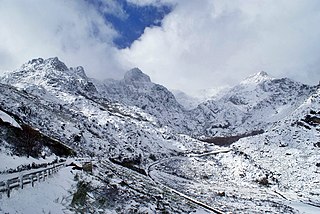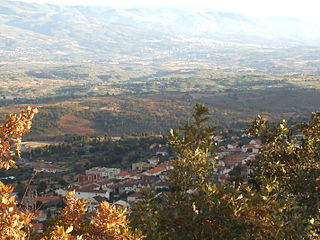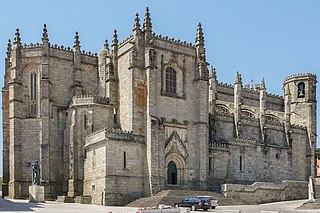
Covilhã is a city and a municipality in the Centro region, Portugal. The city proper had 33,691 inhabitants in 2021. The municipality population in 2021 was 46,455 in an area of 555.60 square kilometres (214.52 sq mi). It is located in the Beiras e Serra da Estrela subregion and Beiras and Serra da Estrela Intermunicipal Community. The municipal holiday is October 20. Sometimes referred to as town of wool and snow, Covilhã is one of the main urban centres of the historical Beira Interior region. The proximity of the mountains offers dramatic scenery and a great environment for those fond of hiking, camping, mountain climbing and skiing. With an industrial tradition historically focused on textile industry supplied by an abundance of wool produced in the area since antiquity, but with a more diversified industry in contemporaneity, Covilhã, which was once known as the "Portuguese Manchester", is also a university city nowadays awarding degrees from aeronautical engineering to medicine to philosophy.

Serra da Estrela is the highest mountain range in Continental Portugal. Together with the Serra da Lousã it is the westernmost constituent range of the Sistema Central and also one of the highest in the system. It includes mainland Portugal's highest point at 1,993 metres above mean sea level. This point is not a distinctive mountain summit, but rather the highest point in a plateau, being known as Torre. Torre is an unusual summit in that it is accessible by a paved road. The peak has a topographic prominence of 1,204 m (3,950 ft) and its parent peak is Pico Almanzor, in Spain.
Aveleda is a former freguesia in the municipality of Bragança, Portugal. In 2013, the parish merged into the new parish Aveleda e Rio de Onor. The population in 2011 was 196, in an area of 62.20 km2. It is situated close to the northern border with Spain.

Altares is a freguesia in the municipality of Angra do Heroísmo on the Portuguese island of Terceira in the archipelago of the Azores. The population in 2011 was 901, in an area of 28.22 km2.

Castro Verde is a town and a municipality of the Alentejo region of Portugal. The population in 2011 was 7,276, in an area of 569.44 km2. Castro Verde is situated in the Baixo Alentejo subregion, within a territory known locally as the Campo Branco . The municipality can be recognized by the local municipal markers along its borders, that appear within its borders to denote its reference as A Window on the Plains; municipal markers appear as stylized house profiles, with an exaggerated window that allows the visitor to see through into the panorama.

Seia is a municipality in Guarda District in Portugal. The population in 2021 was 21,755, in an area of 453.69 square kilometres (175.17 sq mi). Its urban population is about 7,000. Seia was elevated to city status on 3 July 1986. The municipality is situated on the northwestern slope of Serra da Estrela, the highest mountain range in mainland Portugal, with a top height of 1993 meters. The present Mayor is António Luciano Silva Ribeiro, elected by the Socialist Party. The municipal holiday is July 3. Seia has an annual cinema festival called CineEco that focuses on films with ecological and natural themes.

Miranda do Corvo is a town and a municipality in the Portuguese district of Coimbra, with an area of 126.38 square kilometres (48.80 sq mi) and 2011 population of 13,098 inhabitants.

Manteigas is a town and a municipality in Portugal. The population in 2011 was 3,430, in an area of 121.98 square kilometres (47.10 sq mi).

Gouveia is a city and a municipality in the district of Guarda in Portugal. The municipality population in 2011 was 14,046, in an area of 300.61 square kilometres (116.07 sq mi). The town itself has a very small population, around 3.500.

Mangualde is a municipality in the subregion of Dão-Lafões, central region of Portugal. The population in 2011 was 19,880, in an area of 219.26 km2.

Fornos de Algodres is a municipality and a town in Portugal. The population in 2011 was 4,989, in an area of 131.45 km2. The municipality is located in Guarda District, Centro Region, Serra da Estrela Subregion. The present Mayor is Manuel Fonseca, elected by the Social Democratic Party. The municipal holiday is September 29.

Serra da Estrela Ski Resort is a ski resort located in a mountain range named Serra da Estrela, in the municipality of Seia, parish (freguesia) of Loriga, Portugal.

Alcains is a Portuguese civil parish in the municipality of Castelo Branco. The population in 2021 was 4615, in an area of 36.94 km². Alcains is located within the urban agglomeration of Castelo Branco - Covilhã - Guarda, situated 12 km to the north of Castelo Branco, 230 km to the northeast of Lisbon and 280 km southeast from Oporto, while 70 km to the west of the Portuguese-Spanish border and 380 km from Madrid). It is served by the A23_motorway_(Portugal) highway, by the EN18 and EN352 national roadways, and also a rail-line from Beira Baixa Linha_da_Beira_Baixa.

Guarda is a city and a municipality in the District of Guarda and the capital of the Beiras e Serra da Estrela sub-region in central Portugal. The population in 2021 was 40,126, in an area of 712.10 square kilometres (274.94 sq mi) with 31,224 inhabitants in the city proper in 2006. Founded by King Sancho I in 1199, Guarda is the city located at the highest altitude in Portugal and one of the most important cities in the Portuguese region of Beira Alta. Serra da Estrela, the highest mountain range in continental Portugal, is partially located in the district. The city is served by national and international trains on the Beira Alta and Baixa railway lines. The present mayor is Sérgio Costa, as an independent. The municipal holiday is November 27.
Ferro is a town and civil parish in the municipality of Covilhã, Portugal. The population in 2011 was 1,700, in an area of 30.76 square kilometres (11.88 sq mi). Ferro is the Portuguese word for iron.

Santa Cruz is a former civil parish in the municipality of Coimbra, Portugal. In 2013, the parish merged into the new parish Coimbra. In 2001, its population was 6866 inhabitants, in an area of 5.56 km2 that parallels the north (right) margin of the Mondego River, extending to the village of Adémia in Trouxemil.

The Monastery of Santa Maria de Maceira Dão is a monastery in the civil parish of Fornos de Maceira Dão, in the municipality of Mangualde in the Portuguese central subregion of Dão-Lafões, classifies as National Monuments.

The Comunidade Intermunicipal das Beiras e Serra da Estrela is an administrative division in eastern Portugal. It was created in 2013. Since January 2015, Beiras e Serra da Estrela is also a NUTS3 subregion of Centro Region, that covers the same area as the intermunicipal community. The seat of the intermunicipal community is Guarda. Beiras e Serra da Estrela comprises parts of the former districts of Guarda and Castelo Branco. The population in 2011 was 236,023, in an area of 6,304.95 square kilometres (2,434.35 sq mi).

Girabolhos is a civil parish in the municipality of Seia, Portugal. The population in 2011 was 317, in an area of 17.88 km².






















